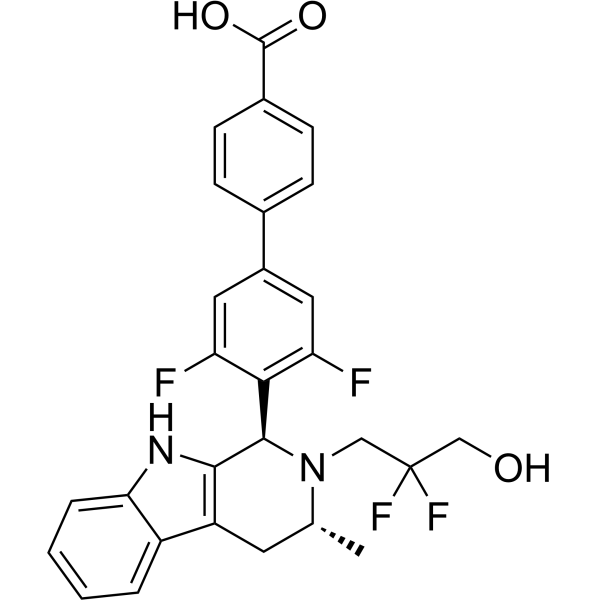Physicochemical Properties
| Molecular Formula | C28H24F4N2O3 |
| Molecular Weight | 512.50 |
| Appearance | Typically exists as solid at room temperature |
| HS Tariff Code | 2934.99.9001 |
| Storage |
Powder-20°C 3 years 4°C 2 years In solvent -80°C 6 months -20°C 1 month |
| Shipping Condition | Room temperature (This product is stable at ambient temperature for a few days during ordinary shipping and time spent in Customs) |
Biological Activity
| Targets | IC50: 14.6 nM (ERα)[1] |
| ln Vitro | ERα degrader 7 (10-5-10 μM, 5 d) is non-cytotoxic to normal breast epithelial cells and has anti-tumor effect against breast cancer cells (IC50 = 4.21 nM) [1]. In MCF-7, ERα degrader 7 (50-1000 nM, 5 d) significantly affects ERα degradation in a concentration-dependent manner [1]. |
| Cell Assay |
Cell Proliferation Assay[1] Cell Types: MCF-10(normal breast epithelial cell) Tested Concentrations: 10-5-10 μM Incubation Duration: 5 d Experimental Results: Demonstrated low inhibition against MCF-10A, cell proliferation rate of each concentration are all above 80%. Cell Proliferation Assay[1] Cell Types: MCF-7(breast cancer cell) Tested Concentrations: 10-5-10 μM Incubation Duration: 5 d Experimental Results: ERα degrader 7(10-3-10 μM) demonstrated excellent antitumor activity against the MCF-7 cell, caused an inhibition rate ranged from 60% to 75%, results were evaluated using GDC-9545 as a positive control. Western Blot Analysis[1] Cell Types: MCF-7(breast cancer cell) Tested Concentrations: 1, 10, 50, 100, 200, 500, 1000 nM Incubation Duration: 5 d Experimental Results: demonstrated a concentration-dependent degradation effect of ERα. Demonstrated a significant ERα-degradation effect(ERα expression rate < 50%) at a concentration of 50 nM, results were evaluated using GDC-9545 as a positive control. |
| References | [1]. Haohao Zhu, et al. Hot-Spot Residue-Based Virtual Screening of Novel Selective Estrogen-Receptor Degraders for Breast Cancer Treatment. Journal of Chemical Information and Modeling. 2023, Article ASAP. |
Solubility Data
| Solubility (In Vitro) | May dissolve in DMSO (in most cases), if not, try other solvents such as H2O, Ethanol, or DMF with a minute amount of products to avoid loss of samples |
| Solubility (In Vivo) |
Note: Listed below are some common formulations that may be used to formulate products with low water solubility (e.g. < 1 mg/mL), you may test these formulations using a minute amount of products to avoid loss of samples. Injection Formulations (e.g. IP/IV/IM/SC) Injection Formulation 1: DMSO : Tween 80: Saline = 10 : 5 : 85 (i.e. 100 μL DMSO stock solution → 50 μL Tween 80 → 850 μL Saline) *Preparation of saline: Dissolve 0.9 g of sodium chloride in 100 mL ddH ₂ O to obtain a clear solution. Injection Formulation 2: DMSO : PEG300 :Tween 80 : Saline = 10 : 40 : 5 : 45 (i.e. 100 μL DMSO → 400 μLPEG300 → 50 μL Tween 80 → 450 μL Saline) Injection Formulation 3: DMSO : Corn oil = 10 : 90 (i.e. 100 μL DMSO → 900 μL Corn oil) Example: Take the Injection Formulation 3 (DMSO : Corn oil = 10 : 90) as an example, if 1 mL of 2.5 mg/mL working solution is to be prepared, you can take 100 μL 25 mg/mL DMSO stock solution and add to 900 μL corn oil, mix well to obtain a clear or suspension solution (2.5 mg/mL, ready for use in animals). Injection Formulation 4: DMSO : 20% SBE-β-CD in saline = 10 : 90 [i.e. 100 μL DMSO → 900 μL (20% SBE-β-CD in saline)] *Preparation of 20% SBE-β-CD in Saline (4°C,1 week): Dissolve 2 g SBE-β-CD in 10 mL saline to obtain a clear solution. Injection Formulation 5: 2-Hydroxypropyl-β-cyclodextrin : Saline = 50 : 50 (i.e. 500 μL 2-Hydroxypropyl-β-cyclodextrin → 500 μL Saline) Injection Formulation 6: DMSO : PEG300 : castor oil : Saline = 5 : 10 : 20 : 65 (i.e. 50 μL DMSO → 100 μLPEG300 → 200 μL castor oil → 650 μL Saline) Injection Formulation 7: Ethanol : Cremophor : Saline = 10: 10 : 80 (i.e. 100 μL Ethanol → 100 μL Cremophor → 800 μL Saline) Injection Formulation 8: Dissolve in Cremophor/Ethanol (50 : 50), then diluted by Saline Injection Formulation 9: EtOH : Corn oil = 10 : 90 (i.e. 100 μL EtOH → 900 μL Corn oil) Injection Formulation 10: EtOH : PEG300:Tween 80 : Saline = 10 : 40 : 5 : 45 (i.e. 100 μL EtOH → 400 μLPEG300 → 50 μL Tween 80 → 450 μL Saline) Oral Formulations Oral Formulation 1: Suspend in 0.5% CMC Na (carboxymethylcellulose sodium) Oral Formulation 2: Suspend in 0.5% Carboxymethyl cellulose Example: Take the Oral Formulation 1 (Suspend in 0.5% CMC Na) as an example, if 100 mL of 2.5 mg/mL working solution is to be prepared, you can first prepare 0.5% CMC Na solution by measuring 0.5 g CMC Na and dissolve it in 100 mL ddH2O to obtain a clear solution; then add 250 mg of the product to 100 mL 0.5% CMC Na solution, to make the suspension solution (2.5 mg/mL, ready for use in animals). Oral Formulation 3: Dissolved in PEG400 Oral Formulation 4: Suspend in 0.2% Carboxymethyl cellulose Oral Formulation 5: Dissolve in 0.25% Tween 80 and 0.5% Carboxymethyl cellulose Oral Formulation 6: Mixing with food powders Note: Please be aware that the above formulations are for reference only. InvivoChem strongly recommends customers to read literature methods/protocols carefully before determining which formulation you should use for in vivo studies, as different compounds have different solubility properties and have to be formulated differently. (Please use freshly prepared in vivo formulations for optimal results.) |
| Preparing Stock Solutions | 1 mg | 5 mg | 10 mg | |
| 1 mM | 1.9512 mL | 9.7561 mL | 19.5122 mL | |
| 5 mM | 0.3902 mL | 1.9512 mL | 3.9024 mL | |
| 10 mM | 0.1951 mL | 0.9756 mL | 1.9512 mL |
